If you want a solid wired network, choosing the right ethernet cable is important. We will discuss all of these points in our ultimate guide, which will help you decide what type of 50 ft Ethernet cable best suits your needs. This article covers everything from cable categories and shielding to durability and performance, so whether this is about setting up an office at home or improving the gaming experience while staying connected through streaming services like Netflix – understanding them will ensure that only those items are purchased that satisfy particular requirements. In the end, we’ll also give some technical details along with use cases on different types of 50 ft Ethernet cables, so by now; you should be familiar enough with the jargon necessary for making an informed choice about what is good for your networking needs.
What is a 50 ft Ethernet Cable, and How is it Different from Other Sizes?
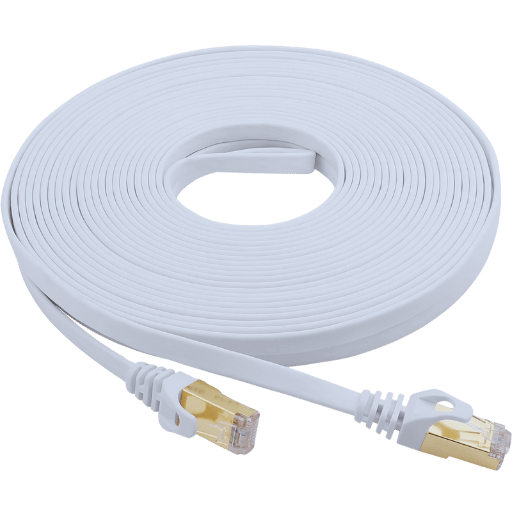
Why Choose a 50 ft Ethernet Cable?
An Ethernet cable that is 50 ft long is an excellent combination of reachability and flexibility, so it can be used for various purposes. For example, this length of cable can connect devices in different rooms or even across large spaces without weakening the signal. What sets it apart from shorter cables is the fact that it does not reduce the strength of a signal too much, as well as other aspects related to latency and degradation of signals, which may take place when longer ones are used. However, this size also avoids very many problems associated with managing cables that are too bulky, especially at home offices, gaming stations, or even small networks where stability plus easy handling are required. In environments like these, long ethernet cables such as 50ft ethernet cables provide more versatility.
Comparing 50 ft Ethernet to Other Lengths
In comparison to shorter lengths such as 10 ft or 25 ft cables, the 50ft Ethernet cable provides much more flexibility when setting up larger systems that involve devices in different rooms or farther apart in a big area. It does this without any significant loss of signal, something shorter cables can suffer from if they need more connections or extenders. On the other hand, compared with longer cables like 75 ft or 100 ft, a 50ft ethernet cable lowers the chances of signal degradation and latency problems, which become worse over longer distances. Additionally, it simplifies cable management due to its manageable length, hence making it easier to install and maintain while still serving most standard applications far enough. All in all, a fifty-foot-long ethernet cable offers practicality between length requirement and need for signal strength as well as ease of installation.
Applications for 50 ft Ethernet Cables
A 50-foot ethernet cable may be used in many ways. In-house and office networks, it is perfect for linking such devices as computers, printers, and routers located in different rooms or far from the main network center. For gaming setups, it provides a stable connection that reduces latency, thus ensuring smooth online gameplay. It also comes in handy in small to medium-sized businesses where multiple workstations need to be connected with servers or network switches without compromising on signal quality, especially when using a 50ft LAN cable. This length is also great for smart home installations such as security systems and smart TVs, among others, which require flexibility and ease of installation across different parts of the house or office when one needs a 50 ft Ethernet cord.
Should You Opt for Cat 6 or Other Categories?
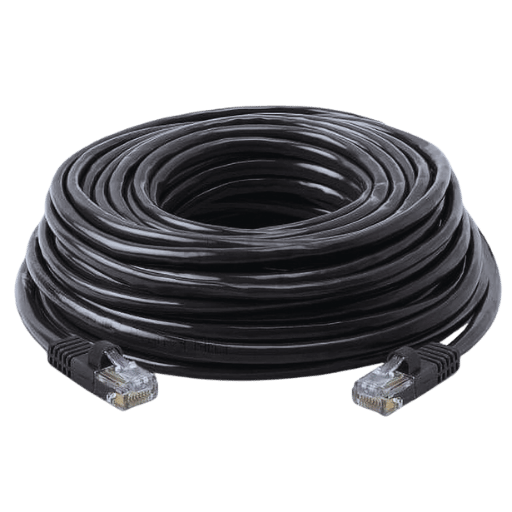
Understanding Cat 5, Cat 6, and Cat 7
Ethernet cables are divided into three groups: Cat 5, Cat 6 and Cat 7. Here’s what sets them apart from one another:
Category 5:
- Max data rate: 100 Mbps.
- Frequency: Up to 100 MHz.
- Good for basic networking or internet with moderate speeds.
Category 6:
- Max data rate: 1 Gbps (up to 55 meters), up to 10 Gbps (up to 33 meters).
- Frequency: Up to 250 MHz.
- Ideal for fast networking, gaming and streaming.
Category 7:
- Max data rate: 10 Gbps.
- Frequency: Up to 600 MHz.
- Best for advanced networking needs, with improved shielding for less interference.
Which group you pick depends on how fast your network speeds need to be — as well as any budget constraints you might have.
Benefits of Cat 6 Patch Cables
Cat 6 patch cords are chosen over their forerunners for a number of reasons associated with contemporary networking. Here’s why:
- Faster Data Transfer Speeds: Cat 6 cables can support data rates of up to 1 gigabit per second (Gbps) at distances of up to 55 meters and up to 10 Gbps for shorter distances (up to 33 meters), making them ideal for high-speed internet, gaming, and streaming.
- Wider Frequency Range: These cables’ frequency capacity is extended to 250 MHz. This means they can handle more data at the same time, which leads to lower latency and smoother transmission.
- Better Interference Reduction: Cat 6 cables have better shielding that reduces crosstalk and electromagnetic interference (EMI), thus giving cleaner signals which are less likely to fail.
- Flexibility: Residential or commercial environments can be fitted with Category 6 patch cords because they connect many different types of devices such as computers, gaming consoles, smart home devices as well as network hardware among others.
- Future-Proofing: By investing in Category six patchcords one ensures that they are prepared for future technological advancements without having the need for immediate upgrades when bandwidth demands increase later on.
These merits serve as evidence enough that the Cat Six Patch cord is highly efficient and reliable both now and in future networking needs.
When to Use Cat 6 Ethernet Cables
When should one use Cat 6 Ethernet cables? There are multiple situations in which these cables provide unique benefits:
- LAN network cable determines the speed of the Internet and networking: For people with homes or businesses that require high-speed connections to the Internet, Category 6 cables can deliver up to 1 Gbps at 55 meters and up to 10 Gbps over shorter distances (up to 33 meters). This makes them perfect for streaming movies in HD, playing games online or transferring large amounts of data.
- Office and Enterprise Environments: In professional settings where many users may need simultaneous access to data intensive applications or cloud services, using Cat 6 cable can help optimize network efficiency by reducing latency thus enhancing overall productivity.
- Future-proofing Your Network: If you anticipate future increases in network traffic or bandwidth requirements, then it would be wise for one to install Category 6 cables so that their network infrastructure will support upgrades without having to replace components every time there is an upgrade. Therefore they are good investments for long term planning and scalability.
By catering for these particular needs, cat six ethernet wires ensure dependability as well as performance that is not only current but also adaptable when it comes to networking demands.
How Does Shielding Impact Ethernet Cable Performance?
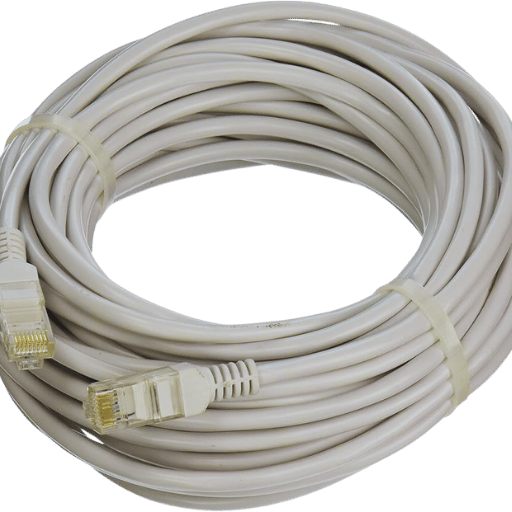
What is a Shielded Ethernet Cable?
Shielded Ethernet cables, otherwise called Shielded Twisted Pair (STP) cables, are constructed with more protective coatings in order to minimize or eliminate electromagnetic interference (EMI) and radio frequency interference (RFI). These types of cable possess shields around the twisted pairs or an overall shield around all the pairs thereby guarding against interferences from external sources as well as crosstalk between adjacent wires. In this connection, shielded Ethernet cables work best where there are numerous electrical devices or installations that produce high EMI/RIF, like factories and other industrial set-ups.
Shielding vs. Unshielded: Pros and Cons
Pros of Protected Ethernet Cables
- Much less interference: Electric and electromagnetic interference is greatly reduced because of the shield; thus, it can be used in areas with high electrical noise levels.
- Better security: Shielding also guards against potential data breaches through electromagnetic radiation.
- Enhanced Data Integrity: These wires maintain higher reliability and integrity of data by reducing crosstalks and external noises which are data-sensitive applications.
Cons of Protected Ethernet Cables
- Higher Costliness: In comparison to unshielded counterparts, this type has more materials, hence making them expensive.
- Complexity in Installation: Special care must be taken during installation so that the ground wire continuity is not broken at any point along its length, sometimes requiring professional installers.
- Flexibility Issues: They are usually stiffer than their non-shielded peers, making them less flexible when routing around corners within tight spaces or cabinets where equipment sits densely packed together.
Pros Of Unshielded Ethernet Cables
- Affordability: They are relatively cheap compared to other types of cables, therefore becoming a choice for people who do not want to spend much on networking infrastructure.
- Easy installation: There is no need for grounding or special techniques during installation; as such, even an ordinary person can quickly connect the wires without any problem.
- Flexibility: Due to their design they can easily bend around corners without affecting performance. This makes them ideal for use in places where there are many turns or twists along the route, such as offices with lots of partitions between rooms, etcetera.
Cons Of Unshielded Ethernet Cables
- Interference Susceptibility: Because there is no shielding, these cables tend to pick up signals from nearby electronic devices like radios leading to degradation or loss of signal quality which may cause frequent packet retransmissions and delays affecting overall network performance especially when used outdoors near power lines or high voltage transformers among others.
- Data Integrity Lowering Effects:The absence of shielding exposes UTP cables to crosstalk which results in higher noise levels thereby reducing the overall reliability of data transmission.
In brief, when choosing between shielded and unshielded Ethernet cables one should take into consideration factors like requirements of particular environments, budget limitations among others. Shielded category provides better protection while ensuring data integrity is maintained at all times but it’s expensive; on the other hand cost-effectiveness comes with ease installation associated with UTPs so decide wisely!
Best Scenarios for Using Shielded Cables
Shielded Ethernet cables are very useful in places where there is a lot of electromagnetic interference (EMI). Examples include the following:
- Industrial Settings: Factories and plants have massive electrical noise produced by heavy machines and wireless devices. These cables help to keep data safe by reducing disturbances, but you can use a gigabit unshielded twisted pair Ethernet for high-speed data transfer.
- Hospitals and Healthcare Facilities: Medical equipment emits significant amounts of EMI. Therefore, shielded cables are necessary to protect critical information transmission from degradation caused by such signals.
- Urban and Dense Office Environments: Buildings that are densely populated with many electronic gadgets and wiring systems require shielded cables to prevent crosstalk while keeping their network performance stable.
Such installations enjoy great advantages due to better shielding, which ensures strong, reliable communication between different points.
What Type of Connectors Do 50 ft Ethernet Cables Use?
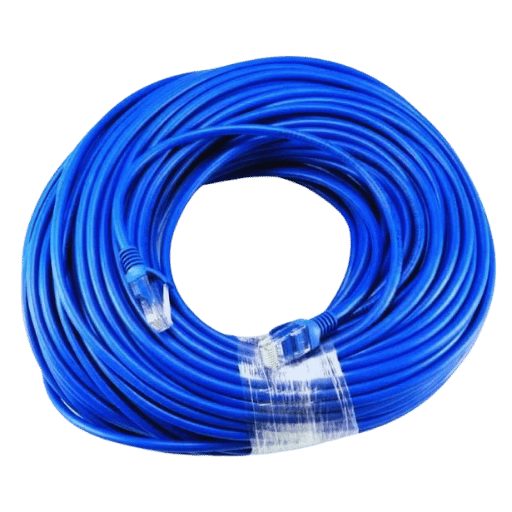
RJ45 Connectors Explained
The RJ45 connector is a standardized interface used for Ethernet networking. It’s an 8P8C modular plug and jack with eight positions and contacts that connect computers or other devices to local area networks (LANs). Below are some features of this type:
- Pin configuration – There are 8 pins on an RJ-45 connector which transmit and receive data. These pins have to be wired in a certain order so that wires can communicate properly within the cable when it is plugged into the device.
- Electrical conductivity – For good electrical conductivity, most RJ45 connectors have gold plating which doesn’t let them corrode over time thereby affecting signal quality.
- Compatibility – RJ-45 connectors can be used with various types of Ethernet cables like Cat5e, Cat6, etc., thus making it universally applicable across different network setups.
- Performance specifications – High-speed data transfer is supported by premium quality RJ45 connectors necessary for gigabit Ethernet (GbE) or even 10 Gigabit Ethernet (10GbE) connections. They are designed to keep signal loss at minimum levels thus lowering crosstalk risks.
- Physical durability – Frequent insertion/removal cycles are taken into account during manufacturing process when creating these connectors. Locking mechanism’s robust design ensures connection stability while preventing accidental disconnections in crowded areas where lots of people pass by each other constantly.
All in all, without reliable performance, versatility and durability provided by modern networking needs would not be met; therefore remaining an integral part of any network infrastructure setup today.
Understanding Snagless Connectors
Definition: RJ45 connectors that do not catch on anything due to having a molded boot that covers the clip are known as snagless connectors. This design feature prevents the locking part from getting caught in cables, equipment or other connectors.
Purpose: To make the connector last longer and improve its durability by protecting the clip from being damaged while it is being installed or removed is the main use of Snagless Connectors. It is specifically valuable in an environment where wires are often moved around with.
Design Features:
- Molded Boot: What sets snagless connectors apart is their unique characteristic which includes a molded plastic boot that encloses the clip so that it cannot be caught accidentally or broken off intentionally.
- Ease of Use: They can be plugged in and unplugged just like regular RJ45 connectors even though they provide more safety which simplifies network maintenance tasks.
Applications: These types of connections would work best when used within places where network cables are handled frequently or reorganized such as data centers, office networks, home setups etcetera.
Benefits:
- Better Protection: The greatest advantage is realized through prevention of clip breakages thus enhancing cable reliability on overall basis alongside extending its life span too.
- Professional Appearance: In structured cabling environments, sleek-looking snagless connectors help achieve neatness by reducing clutter as well as tangling, hence giving them a clean finish that appears professional at all times.
All in all, what makes cables remain operational throughout their usage period while also ensuring security for different points connecting the network? Snagless connectors!
Compatibility with Routers and Other Devices
Snagless connectors work well with many types of networking equipment, such as routers, switches, and other devices that use standard RJ45 ports. Their design allows them to be used interchangeably among different network hardware brands and models without needing any changes or special adapters. This applies equally to home and business network setups thus making these connectors versatile in ensuring strong and reliable connections between networks. According to reliable sources, they are favored over other alternatives due to their ease of installation and long-lasting nature that contributes significantly towards attaining excellent network performance levels.
How to Maintain and Extend the Life of Your Ethernet Cable?

Proper Storage Techniques
For Ethernet cables to last long and work well, they should be stored properly. In the first place, one must not fold or twist the cables, which can break inner wires. Rather than that, employ a slack winding method to keep them straight without kinks. At the same time, keep off from congested places full of people and heavy machinery since you risk endangering it physically. To have a particular order with no crumpling, you may use cable organizers/ Velcro straps; this will help avoid getting tangled up among others. Finally, maintain the cables in cool, dry places, as excessive moisture or extreme temperatures can cause degradation.
Common Issues and How to Avoid Them
Ethernet cables may have a range of common problems affecting network performance, such as cable wear, signal interference, and poor connections. To prevent such:
- Cable Wear: Check regularly for signs of damage, such as fraying or exposed wires, then replace any worn-out ones immediately to keep them working at their best. If not managed properly, long ethernet cables are more prone to damage.
- Signal Interference: Opting for a cat6 cable can help mitigate this issue as it provides better performance over longer distances. Keep ethernet cables away from electrical wires and devices that emit electromagnetic interference. Use shielded Ethernet cables (STP) in environments with high interference.
- Poor Connections: Sometimes LAN network cables are subpar which leads to poor connection quality. Make sure connectors are firmly attached into ports. Connectors and ports should be cleaned periodically using appropriate tools since dust or debris may hinder connectivity.
- Improper Length: Excessively long cables introduce latency and reduce signal quality thus should be avoided where possible; only use a 50ft cable when necessary. Select the right cable length for your setup then consider using a repeater or switch for extended runs.
By taking these common issues into consideration ahead of time you greatly improve the reliability as well as overall performance within your network system.
Using Cable Clips for Better Management
The organization and usefulness of ethernet cable setups are boosted by the use of cable clips. They fasten cables along walls, desks, or other surfaces so that there is no tangling or accidental disconnection, which leads to a more streamlined and efficient network environment. When using cable clips:
- Choose the Right Clip Size: Go for clips which can hold your Ethernet cables securely by fitting their diameter tightly enough. Using an appropriate size ensures that cables are kept firmly in place.
- Proper Placement: Install these at regular intervals – typically every 12-18 inches apart – to maintain even tension throughout the length of the run; this also prevents sagging as well. Place them close to connectors and key junction points for extra stability.
- Durability & Material: Use strong materials like nylon or heavy duty plastics when making these items so they can withstand wear and tear over time; adhesive-backed ones offer easy installation whereas screw-mount ones provide a more permanent solution.
- Aesthetic Considerations: Select those with colors matching or complementing the surfaces upon which they will be fixed for neatness purposes because it makes them look good, too, besides reducing visual clutter around such areas.
By incorporating cable clips into your system of managing wires, you greatly improve physical safety standards within the network infrastructure while enhancing its performance at large. Well-maintained connections decrease chances of signal loss due to physical damages and signal degradation caused by poor quality connections leading to fewer errors during data transmission phases, among others too.
What Factors Affect the Bandwidth of Ethernet Cables?
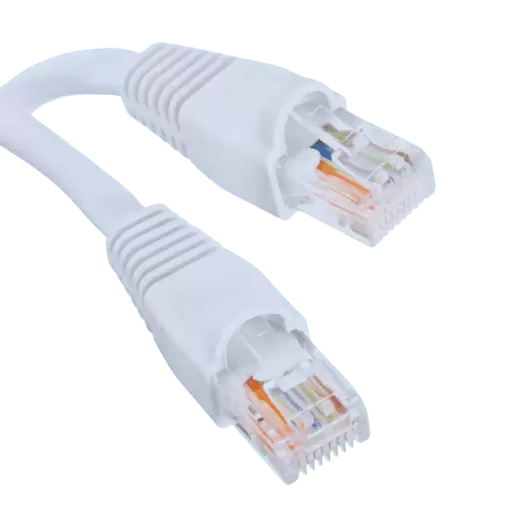
Understanding Bandwidth in Ethernet Cables
Various factors affect Ethernet cable bandwidth:
- Cable Category: Different types (Cat5e, Cat6, Cat6a, Cat7, Cat8) have different speed and capacity ratings – higher categories generally mean more bandwidth.
- Length of Cable: The longer the cable runs, the worse the signal becomes, thereby reducing effective bandwidth. It is, therefore, important to follow the recommended maximum distances for each type.
- Interference: Bandwidth can be lost due to electromagnetic interference from other electronics close by as well as crosstalk among wires themselves; this is why shielding such cables(E.g., STP) against these effects is necessary.
- Connector Quality: When connectors are not made well or terminated incorrectly, then there will be a loss of signals, which will affect the amount of data transmitted through them, thus impacting available bandwidth. So always use good quality ones and follow the correct installation procedures.
- Environmental Factors: Performance may be affected by extreme temperatures or mechanical stress placed upon them during usage so it’s advisable that they should only be installed where there are controlled conditions for their safety maintenance purposes.
By taking into account all these things one can maximize both network reliability and efficiency with respect to their own requirements on an Ethernet-based system design.
The Role of Cable Quality in Bandwidth
Determining bandwidth capacity as well as overall network performance in ethernet cables is highly dependent on their quality. When making high-quality cables, better signal transmission and reduced signal loss are achieved through the use of improved materials. There is usually enhanced shielding, such as cables, that help to minimize electromagnetic interference (EMI) and crosstalk, which are important for keeping up with high bandwidth. Data integrity is also affected by how well connectors are built and how precisely cable terminations are done, thus reducing errors and possible degradation in performance. If you want constant fast data transfer over a network, then invest in good-quality cables.
How to Maximize Your Cable’s Bandwidth
If you want to get the most out of your Ethernet Cable, then just follow these simple steps:
- Use a Good Quality Cable – This is important because cheap cables can cause signal loss which will limit speeds. High-quality cables are made with better materials and have better insulation so they transmit signals more efficiently.
- Cable Management – Proper cable management can help reduce complications when setting up ethernet connections, especially with 50ft ethernet cables or any other long ones. It’s good for keeping things neat and tidy but also has functional benefits too; well-managed cables are less likely to become tangled or damaged.
- Prevent Interference – Power cables generate electromagnetic fields that interfere with network traffic; try as much as possible to keep them separate from each other. Another way is by using a shielded twisted pair (STP), which protects wires from outside interference.
- Secure Connections – Ensure that all connectors fit snugly into their ports and no physical damages occur at connection points otherwise it may lead to poor contact between pins resulting in intermittent connections or complete failure. Use only high-quality connectors for better results.
- Regular Maintenance – Check for any signs of wear and tear on the cable jackets as well as connector pins. Replace damaged parts immediately before oxidation sets in due to exposure over time thereby reducing contact surface leading to higher resistance levels causing dropouts or slower speeds during data transfer within LAN system.
By doing these things, you’ll be able to maximize bandwidth while still maintaining fast internet speed throughout your entire home network.
Reference Sources
Ethernet
Modular connector
Category 6 cable
Frequently Asked Questions (FAQs)
Q: What should I consider when buying a 50 ft ethernet cable?
A: When purchasing a 50 ft ethernet cable, consider the category (such as cat6 ethernet cable), shielded or unshielded (cable shielded or unshielded), construction (up or stp), and whether you need special features like snagless boot.
Q: Is a cat6 snagless Ethernet cable better for a home network?
A: Yes, typically, a Cat6 snagless Ethernet cable is better for a home network because it offers higher speed and less interference, which is great for streaming, gaming, and other high-bandwidth activities.
Q: How important is shielding in a cable shielded 50 ft Ethernet cable?
A: Shielding can be very important in an environment with lots of electromagnetic interference (EMI) or radio frequency interference (RFI) so that data loss is prevented and overall performance improved for cables such as these which are designed specifically for this purpose, also known as “Cables Shielded”.
Q: What is the difference between flat Ethernet cables and round ones?
A: Flat Ethernet cables are more flexible to route under carpets or along walls, while round ones have more vital wires with better shielding. Be aware, though, that both could be cat6 ethernet cables; therefore, choose according to what you want them installed for.
Q: Can gigabit speeds be supported over a CAT 6 Ethernet cable 50 ft?
A: Yes, if properly installed and supported by network devices, then gigabit speeds will indeed travel through this length of cabling, reaching up to 1 Gbps.
Q: What is an Ethernet patch cord used for?
A: An Ethernet patch cord, also known as a patch cable, is used to connect devices together within a Local Area Network (LAN), such as computer-to-switch connections. Depending on your network setup, these can be either category six Ethernet cords or any other type.
Q: Should I use a UTP Ethernet cable for my LAN network?
A: Most LAN networks would benefit from using UTP ethernet cables, especially where there is minimal electromagnetic interference. They are cheaper than shielded options and more flexible, thus easy to work with when routing them around corners or through tight spaces.
Q: What does snagless boot mean on an Ethernet network patch cable?
A: A snagless boot refers to a design feature of the connector clip on an ethernet network patch cable that prevents it from getting caught or broken when being pulled through tight spaces. This is particularly useful in high-density networking environments.
Q: Are there any advantages to using a bare copper Ethernet cord?
A: Bare copper ethernet cords provide better conductivity and signal quality than copper-clad aluminum (CCA), offering more robust performance over longer distances like 50 feet.
Q: Can I use a twisted pair Ethernet cat6 patch cable for an internet network LAN?
A: Yes, a twisted pair Ethernet Cat6 patch cable is suitable for use in an internet network LAN. A 50-foot Cat6 ethernet patch cable can be particularly handy here as it provides high-speed connectivity while supporting gigabit Ethernet, allowing you to connect various devices within your LAN network.
Post Views: 2,970





